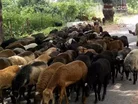Livestock responsible for majority of world diseases

Medical New Today states that a zoonose, or zoonosis, is “any kind of infectious disease that can be transmitted from animals to humans and vice-versa.” At any given moment there are almost 24 billion livestock worldwide, including pigs, poultry, cattle, goats, sheep and camels.
Examples of zoonoses include bird flu, AIDS, anthrax, tuberculosis and Rift Valley fever, with the real danger coming from areas where disease are particularly virulent or are becoming resistant to drugs used to treat them. The research team warned that an exploding demand for livestock products means the problem is likely to get worse in years to come.
To read the latest edition of Healthcare Global, click here
- Alzheimer's Research UK welcomes new Chairman
- Infants not feeling fine in the summertime
- DON'T sit still and START fidgeting, say doctors
The study found that just 13 zoonotic diseases are responsible for 2.4 billion cases of human illness and 2.2 million deaths every year. As expected, the highest cases of infections/deaths occur in poverty-stricken countries which suffer from malnourished populations coupled with the a huge number of livestock keepers.
India was named as suffering from the most zoonotic disease burden, with Ethiopia, Tanzania and Nigeria taking second, third and fourth respectively. However, the research also showed that the United States, Western Europe (especially Britain), Brazil and parts of Southeast Asia are all areas of “emerging zoonosis” hotspots.
Veterinary epidemiologist and food safety expert with ILRI in Kenya and lead author of the study, Delia Grace, explained:
“From cyst-causing tapeworms to avian flu, zoonoses present a major threat to human and animal health. Targeting the diseases in the hardest hit countries is crucial to protecting global health as well as to reducing severe levels of poverty and illness among the world’s one billion poor livestock keepers. Exploring global demand for livestock products is likely to fuel the spread of a wide range of human-animal infectious diseases.”
Currently 60 percent of known infectious diseases are zoonotic in nature, with nearly three-quarters of emerging disease zoonotic in nature.
Despite the dangers zoonoses pose, Deputy Director General-Research at ILRI, Steve Staal, commented that increasing global demand for meat could help lift livestock keepers out of poverty:
“Increased demand will continue over coming decades, driven by rising populations and incomes, urbanisation and changing diets in emerging economies. Greater access to global and regional meat markets could move millions of poor livestock keepers out of poverty if they can effectively participate in meeting that rising demand.”
Grace concluded:
“These findings allow us to focus on the hotspots of zoonoses and poverty, within which we should be able to make a difference.”



